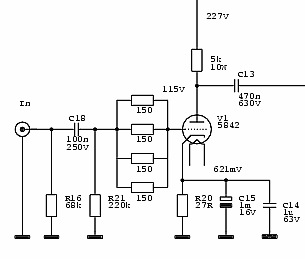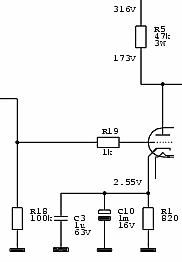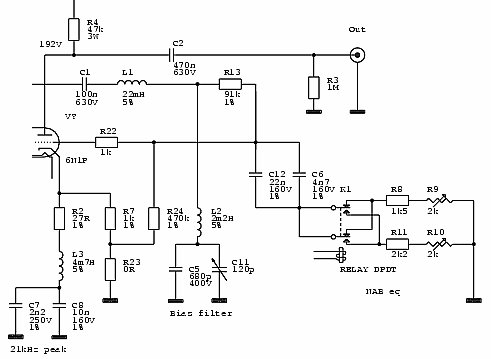The third stage is where most of the "interesting" stuff happens. All the filters are placed
in this section.
The amp in this section is the other half of the 6N1P. The stage is similar to the second stage. One
difference is that the cathode resistor R2 is not decoupled by a big electrolytic cap. Instead there
is a series resonant filter consisting of L3, C7 and C8 that resonates at 21kHz. This creates a small
peak in the frequency response around 21kHz, that is there to compensate for losses in the playback
head. The resistor R2 decreases the Q of the filter making the peak less sharp.
The second filter is the bias filter. This filter is placed between the second and third stage and consists
of the parts L1, L2, C5 and C11. It creates are lowpass filter that removes any residual bias signal
from the tape, to avoid problems like high-frequency instability in the following amp. The lowpass frequency
can be adjusted by the trimmer C11. The -3dB frequency can be adjusted between 35 and 40kHz.
The third filter creates the NAB eq (de-emphasis). It consists of the parts R13, C6, C12 and either
R8+R9 or R10+R11. This filter creates a low pass that becomes active above 50Hz and "stops working"
around 4kHz. The high frequency part can be adjusted by the trimmers R9 and R10. The reason there's
two of them is to provide settings for two different speeds. In my case I will need 3.75 and 7.5ips.
The frequency response probably won't be perfect at 3.75ips, but since I only have old tapes recorded
at that speed, I don't care much about that. By making the 21kHz peak filter switchable the response
could easily be made perfect though. 15ips uses the same eq as 7.5ips, so 15ips should work just fine
- I don't have any decks to test that with though.
The output is taken from the plate (anode) of stage three. That makes the output impedance quite high,
so the input impedance of the following preamp or poweramp should be 100kOhm or higher. Is that is not
possible (or if long cable runs are needed) a buffer stage like a cathode follower should be added.
I will probably add one later.
|



